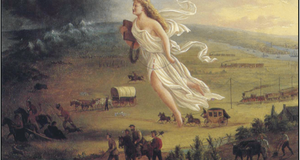Student VoicesHumanity and Its Place in Nature: Rethinking the Reality of 'Wilderness'
By
2014, Vol. 6 No. 09 | pg. 2/2 | « America’s wealthiest citizens became increasingly interested in the preservation of the most sublime areas of the country in the late 1800s and early 1900s. The “myth of the wilderness as ‘virgin’ uninhabited land” became a “highly attractive natural alternative to the ugly artificiality of modern civilization” (Cronon, 1995, p. 78-79), especially to America’s elite. This myth, of course, was false considering that these “virgin” lands had been occupied by Native Americans for thousands of years. Nonetheless, Native Americans were rounded up by thousands and forced off their lands into reservations so “tourists could safely enjoy the illusion that they were seeing their nation in its pristine, original state” (Cronon, 1995, p. 79). Of course, many Americans failed to understand the intricate relationship between Native Americans and their land partly because “the dream of an unworked natural landscape is very much the fantasy of people who have never themselves had to work the land to make a living” (Cronon, 1995, p. 80). In the future, “understanding the social dynamics that initiate and sustain the new landscapes” (Mertens, 2008, p. 39) will be critical for conservationist and policy makers throughout the world. The Blackfeet Native American Tribe, as Cronon (1995) explains, continues to be accused of poaching on the lands of Glacier National Park that had been their ancestral home for thousands of years (p. 79). From my own experience, I can indeed remark that the initial drive through the magnificent Glacier National Park on the way to the Blackfeet Reservation is enthralling, as the park appears to be nature in its most perfect and pristine form. I vividly recall the incredible beauty of the park—from its stunning waterfalls to its towering mountains. When I arrived at the reservation, however, I noticed a stark contrast between the beauty and prosperity of the national park and the devastation and poverty of the small and squalid reservation. While the Blackfeet people had lived for thousands of years in close balance with the land that is now Glacier National Park, they are today banished from the land and forced to live on a small reservation. Like other marginalized indigenous people displaced from their homelands, the Blackfeet Native Americans struggle to maintain their cultural identity and struggle with poverty, substance abuse, and continued oppression by the federal government. If we adhere to the conceptualization that we are supposedly separate from wilderness and nature then we eliminate the “hope of discovering what an ethical, sustainable, honorable human place in nature might actually come to look like” (Cronon, 1995, p. 81). It is distressing to think how difficult it is for the Blackfeet to sustain their culture when only a few hundred years ago they thrived in a land they are now restricted from. While tourists such as myself are permitted to hike, climb, and dive off cliffs in Glacier National Park, the Blackfeet are prohibited from the activities that they maintained for many centuries.Our Western notion of wilderness has meanwhile been exported to the rest of the world. Today, “Third World countries face massive environmental problems and deep social conflicts” (Cronon, 1995, p. 82) because of the exportation of Western notions of wilderness that have “become an unthinking and self-defeating form of cultural imperialism” (Cronon, 1995, p. 82). Woods (2001) asserts that the central problem within modern environmental philosophy is the belief that “wilderness supposedly represents the quintessential non-human, natural-world that, many argue, is deserving of our protection” (p. 350). In terms of displacing indigenous peoples from their ancestral homelands, Woods (2001) reminds us “to acknowledge that wilderness preservation in practice can be morally problematic by pitting people against wilderness” (p. 357). This leads us into what Cronon (1995) refers to as a central paradox, that “wilderness embodies a dualistic vision in which the human is entirely outside the natural” (p. 80). If we adhere to the conceptualization that we are supposedly separate from wilderness and nature then we eliminate the “hope of discovering what an ethical, sustainable, honorable human place in nature might actually come to look like” (Cronon, 1995, p. 81). Ultimately, the starting point for addressing issues of environmental justice is to recognize our intricate role and relationship with nature. The pursuit of justice demands that we learn from past failures and ensure that atrocities committed against marginalized groups not be committed in the name of ‘preservation.’ While protecting and preserving our natural world is undeniably important, humans are integral components of nature and as such deserve equal care and protection. ReferencesCronon, William. (1995). The trouble with wilderness; or, getting back to the wrong nature. Uncommon Ground: Toward Reinventing Nature. (pp. 69-90). New York: W. W. Norton & Company. Mertens, Richard. (2008, September-October). Can’t see the forest for the trees. University of Chicago Magazine, 101, 37-39. Woods, Mark. (2001). Wilderness. In Dale Jamieson (Ed.), A Companion to Environmental Philosophy (pp. 349-361). Oxford: Blackwell Publishers, Ltd. Suggested Reading from Inquiries Journal
Inquiries Journal provides undergraduate and graduate students around the world a platform for the wide dissemination of academic work over a range of core disciplines. Representing the work of students from hundreds of institutions around the globe, Inquiries Journal's large database of academic articles is completely free. Learn more | Blog | Submit Latest in Environmental Studies |
















